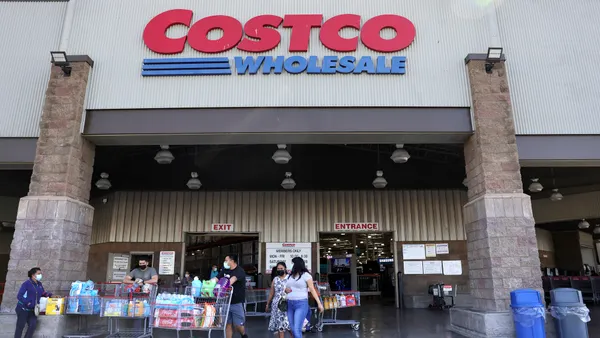Dive Brief:
- In a first quarter defined by the new coronavirus, Target's comparable sales rose 10.8%, the company said in a press release.
- Digital sales, which rose a whopping 141%, accounted for 9.9 percentage points of that comp expansion. Helping to drive that figure were Target's same-day services — pick up, drive up and Shipt — which grew 278% in Q1.
- At the same time, increased costs and declines in sales of higher-margin products dragged on Target's profits. Operating income fell by more than half year over year, to $468 million, while its gross margin rate fell by four and a half percentage points to 25.1%.
Dive Insight:
Target's banner top-line — which increased 11.3% from last year to $19.4 billion in Q1 — masks the complicated, volatile and extreme changes that the business and its shoppers went through in the early months of the year.
As the retailer indicated earlier, it saw unprecedented demand spikes over some categories, with customers stockpiling food, cleaning supplies and other household essentials as they braced for stay-at-home orders, possible quarantines and the general, anxiety-inducing uncertainty of the pandemic.
Target was among the retailers allowed to stay open as states moved to shutter nonessential retail stores such as clothing shops. As a mass merchant, Target's sales weren't immune to slowdowns as consumers shifted their spending toward essential goods, with not just the pandemic but also an economic crisis setting in on the country.
Target took inventory impairments in Q1 related to the "rapid slowdown" in apparel and accessories sales at the retailer, as well as an "unfavorable category mix," indicating booming sales of food and other low-margin goods. CEO Brian Cornell said in a conference call that comps in apparel — a bragging point for the retailer in recent periods — fell 20% in the quarter.
The retailer also had to make operational and spending changes to meet the rush of purchases. The company previously announced it had scaled back near-term store investment plans to focus on meeting pandemic demand. Target also boosted wages for employees, who were frontline workers as the disease spread through the country, and also saw higher digital and supply chain costs as digital sales volume exploded. Altogether Target made hundreds of millions of dollars in new costs, Cornell said.
Cornell called the demand increase "crushing," with days in April where digital orders surpassed those on Cyber Monday. And unlike Cyber Monday, Target didn't have months to prepare and plan for the demand spike. All of that followed what Cornell described as a relatively normal February month in the quarter.
Charlie O'Shea, lead analyst for Target at Moody's, said Target's performance for the quarter exceeded the ratings firm's expectations. O'Shea noted the pressures on Target's margins, including from the higher costs associated with digital sales. "[H]owever using stores to fulfill around 80% of these sales, which is efficient given Target's locally-curated stores, mitigates some of these cost pressures," O'Shea said.
GlobalData Managing Director Neil Saunders described Target as one of the "beneficiaries of the pandemic" while noting the hit to Target's bottom line. "This is the reality of retailing during the crisis: those retailers that remained open got a spike in trade, but the cost of servicing that business was punishingly high," Saunders said.
Saunders pointed out that soon Target will have much more competition across its assortment as other retailers reopen. But Cornell and his team said they think Target made lasting gains during the Q1, winning market share across key categories as well as new customers.
The company, though, isn't providing financial guidance for the year, acknowledging the uncertainty the pandemic brings. Target also added disclosures around risk to its business from COVID-19 including new costs, operational challenges like out-of-stocks and foot traffic metering, and economic volatility.
On the call, Cornell acknowledged that "the one thing that seems certain is continued volatility." He also said that, "I wouldn't trade Target's long-term prospects for anyone else's in the market."
Clarification: This article was changed to clarify Charlie O'Shea's title. He is the lead analyst for Target at Moody's.














